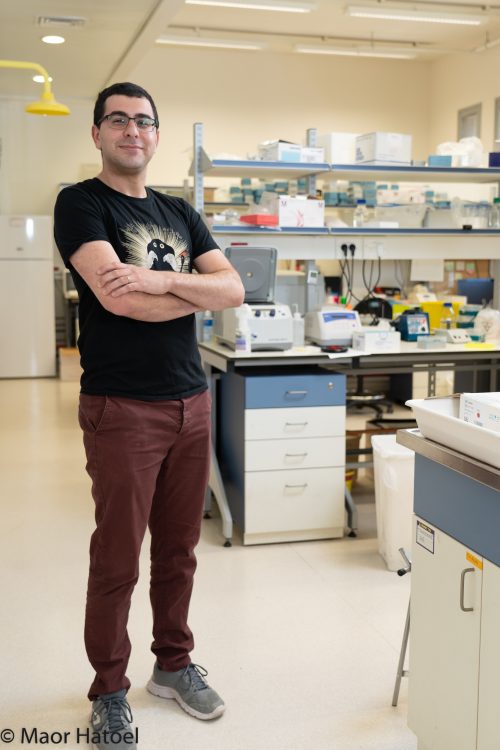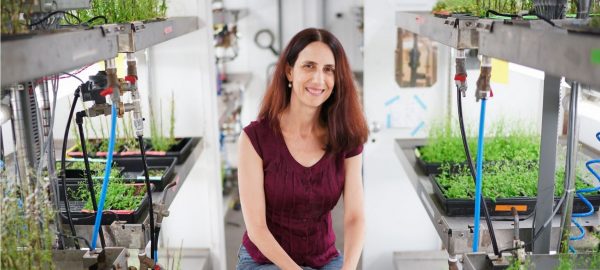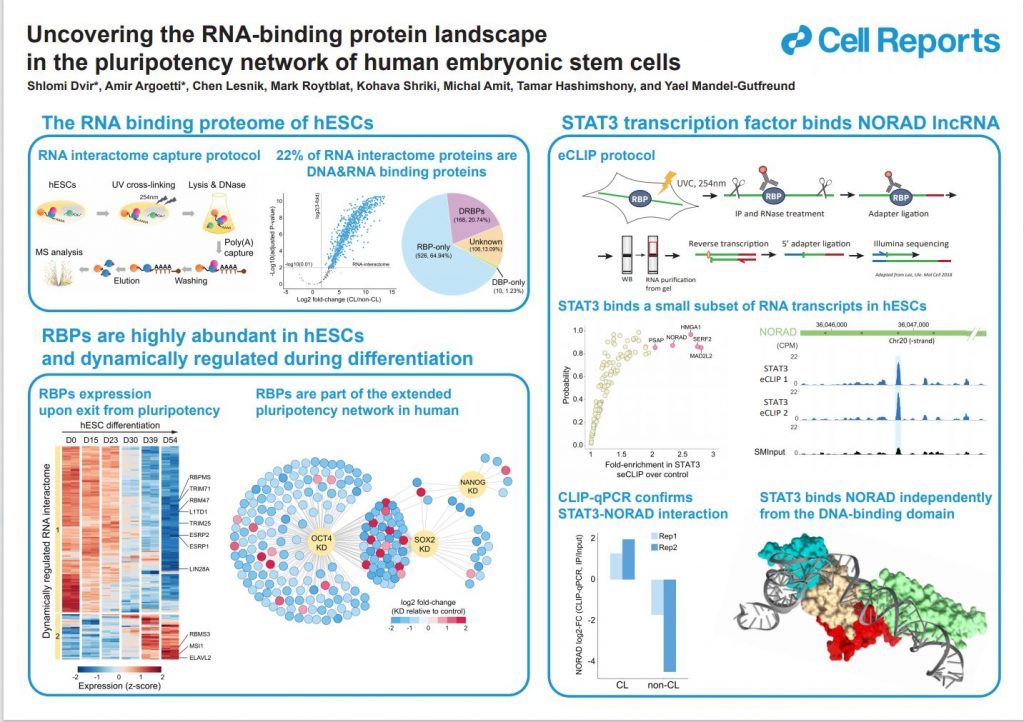March 2021 Paper of the Month
The March Paper of the Month winner is Ph.D. student Amir Argoetti from Prof. Yael Mandel-Gutfreund’s lab
Every month, the Faculty of Biology’s Graduate Studies Committee chooses the best paper of all the scientific papers published in that month.
We are happy to announce that the March Paper of the Month winner is Ph.D. student Amir Argoetti from Prof. Yael Mandel-Gutfreund’s lab, whose paper has been accepted for publication in Cell Reports.
We used this opportunity to ask Amir about his research, the stories behind it, and a little bit about himself
Hi. A Can you tell us a few words about yourself?
“I’m Amir, married to Anna, and a direct Ph.D. student in Prof. Yael Mandel-Gutfreund’s lab. I got my B.Sc. in Environmental Economics and Biotechnology from the Faculty of Agriculture, Food and Environment at Hebrew University. During this past year, I started using the Internet and social media to make science accessible to the general public – mainly with regard to COVID-19 and vaccinations, but not just that. As part of this endeavor, I volunteer in the Midaat association for informed health.”
Briefly, what does the Mandel-Gutfreund lab do?
“The lab studies different aspects of gene expression regulation using both computational and experimental methodologies. We study the role of RNA-binding proteins in gene expression regulation during fetal development and following viral contamination. The lab’s researchers and students come from a variety of different backgrounds – biology, computer science and engineering, but the boundaries are pretty blurred, and most of us do experimental as well as computational work.”
Tell us about your current paper/study. What was the purpose of your research, and what have you found?
“The paper describes a research project conducted by Dr. Shlomi Dvir and myself, my first “wet” project in the lab. Our purpose was to identify RNA-binding proteins (RBPs) in human embryonic stem cells and understand their role in maintaining pluripotency, which is the ability of stem cells to remain stem cells and differentiate into embryonic tissues. One particular type of RBP that was of special interest to us was dual nucleic acid-binding proteins, i.e., proteins that can bind both DNA and RNA, thus mediating between different pathways in gene expression regulation. During our work, we discovered dozens of transcription factors that bind RNA in addition to DNA, for example, OCT4 – a major transcription factor known to maintain pluripotency. The greatest discovery of our research was that the STAT3 transcription factor, whose function in mouse embryonic stem cells is well known, binds non-coding RNA whose function in human embryonic stem cells has been unknown so far.”
Could you explain the importance of this discovery? How can you use it, and what possibilities does it open up? What are its potential applications (fields, solutions)?
“This discovery opens up new possibilities for research to understand the influence of RBPs on embryonic stem cell maintenance and differentiation and raises questions about the unusual role of these proteins in transcription regulation.”
 Can you tell us some more about the process of your work, and how you came up with the idea?
Can you tell us some more about the process of your work, and how you came up with the idea?
“For many years, our lab has been asking what mediates gene expression regulation processes, some of which occur in the nucleus, and some in the cytoplasm. One of the hypotheses was that some proteins can bind both RNA and DNA and thus serve as mediators and regulators of these processes.
Embryonic stem cells are an excellent model of a system in which coordination of time and place between the processes is crucial. Those cells can keep dividing indefinitely and remain undifferentiated, but once they receive the right signal, they can differentiate into any cell in the body. In an attempt to answer our research question – or, more specifically, what mediates the interaction between different cellular regulations – we chose to concentrate on human embryonic stem cells and tried to identify new RBPs that mediate the various regulation processes by using a combination of computational and experimental approaches.
For the purposes of the study, we established an experimental lab and integrated it with the existing bioinformatic one. Together we developed adjusted experimental and computational methodologies to deal with the research challenges. That approach helped us find many potential candidates which are being studied at the lab as we speak.”
What appealed to you about the lab / this project?ֿ
“In my B.Sc., I did a double major in Biotechnology and Economics – not because I liked Economics, but because I thought we biologists could use a better mathematical and statistical background. As I was looking for a lab for my M.Sc., I thought one that was studying RNA and combining molecular and computational biology would be a perfect match for me. Lucky for me, Yael thought the same.”
Any interesting stories from this research?
“Four years ago, I went to Germany to study a method that helps find protein interactions with RNA (CLIP). When I came back to Israel, I bought a bottle of whiskey that I was planning to open as soon as the CLIP would work. After a year and a half of hard and frustrating work, it finally worked, and we got some good and interesting results (see Figure 2 in the article). Unfortunately, it happened exactly on the day my grandmother died. The bottle opening was postponed until the publication of the paper, and I’m glad to inform you it was ceremoniously opened last week!”
How important would you say creativity is in science? It doesn’t all start and end with numbers and measurements, does it? Are there any additional elements in one’s attitude/thinking/skills that may help advance scientific breakthroughs?
“Wow, for me it’s extremely important. Professional literature and conventional methods can only get you so far, but for innovative research you need an innovative approach, something you can’t just read up on in the literature. From that point on, to move forward, you need to understand the basic science and use your imagination to make unorthodox combinations of ideas and techniques.
In this research we tried to adapt the CLIP to our needs, and for a long while we couldn’t manage to improve its efficacy so it would work for proteins that bind little RNA. The enlightenment came to me as I was hiking Mount Carmel, and tried to imagine I was an RNA molecule trying to detach itself from the membrane. This led to a major breakthrough in our research, and I’m extremely proud of it to this day.”
What do you do when you’re not doing science?
“Tweet about science and make coffee and cakes. My wife, Anna, says I never stop doing science, even in my free time.”
What is the one thing no one knows about you?
“When I was a kid, I participated in a Shakespearean play at the Cameri Theater as a choir boy (I won’t tell you the name of the play, to spare myself the embarrassment).”
What do you want to be when you grow up? “A scientist.”
Seriously now, what are your career plans?
“I’ll start with a postdoc and see how it goes. I would very much like to pursue a career in research, but I know the academy is a very competitive field, so I’m hoping to find the right place for me and enjoy it…”
Any tips for new students? “Go study Computer Science (less competition for me…)” (LOL)








